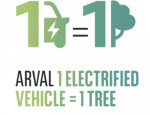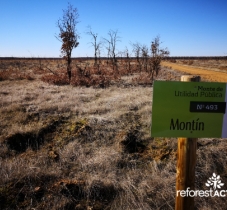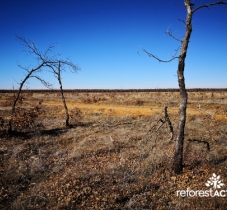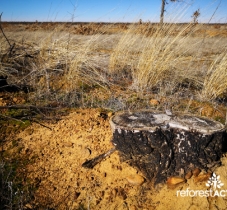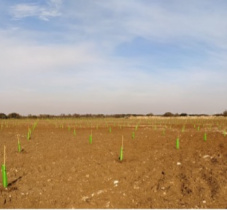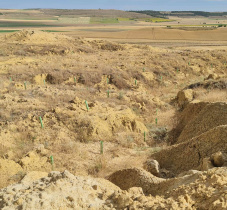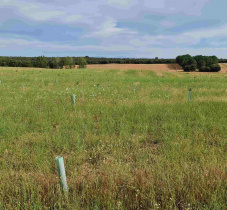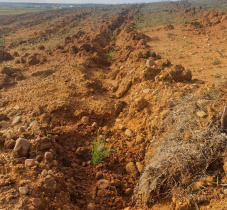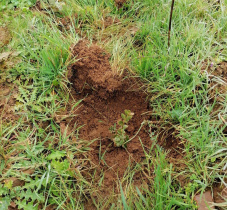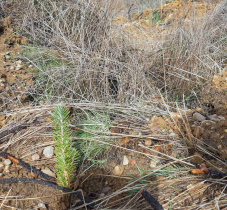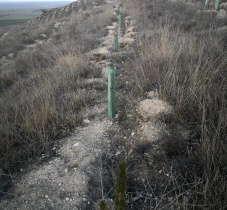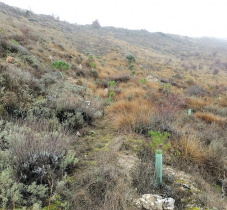Project description
In the center of the autonomous region of Castilla-y-León is the city of Palencia. Many of the surrounding municipalities are suffering from a significant agricultural decline and devastating fires. Several local and mixed species will be introduced and will offer a stable ecosystem rich in biodiversity. We invite you to participate in this project identified by our partner Sylva Nova.
The project at a glance
- Number of trees planted: 250,521 trees over 5 years
- Plantation area: + 200 hectares
- Species planted: chestnut, tauzin oak, faggot oak, black alder, cherry, black pine, maritime pine, bird's sorb, Aleppo pine, umbrella pine, almond, juniper, incense juniper, holm oak, cork oak
- Type of project: restoration of a degraded areas
The origin of the project
This project started 5 years ago in Palencia, in the center of the autonomous region of Castilla-y-León. The forestry challenges of this region are very important: the agricultural decline is very strong, due in particular to a very important rural exodus. On the other hand, many forest fires have occurred in recent years, thus deeply degrading biodiversity, soils and landscapes. As the scope of the project has greatly increased, the projects now extend over the entire region.
Project's objectives
The main objective of the project is to restore a diverse forest ecosystem that had disappeared, so that it can once again deliver biodiversity while providing the local population a restored natural landscape which will revive both tourism and the economy. All of this will be done in the context of the fight against climate change.
- 2017 - 2019 program
2017 marks the beginning of the recovery of post-fire vegetation cover in several municipalities in the area of Santervàs de la Vega, after the terrible fires of 2005 and 2016 that ravaged nearly 250 hectares of forest. These forests are located near the Montaña Palentina Natural Park, north of Palencia, where it is not uncommon to find wolves and bears. 21,865 trees (chestnut, oak, oak, alder, cherry, black pine, maritime pine, mountain ash) are planted in a mixture. In addition, as the nature park is very popular with tourists, the landscape benefits provided by this project will fuel visitor attraction to the area.
- 2019 - 2020 program
Two new areas are added to the project: Tamaras de Campos and Castrillo de Duero, villages located in the Castilla-y-León region, near Palencia. The objective here is to fight against erosion, reforest a burnt out scrubland and afforest agricultural land to extend the vegetation cover. 60,000 trees of different species (Aleppo pine, umbrella pine, incense juniper, almond, juniper) have been introduced in this planting season. In Castrillo de Duero, the neighboring winegrowers of the plantation area are delighted: this plantation allows to stabilize the soil and to avoid the mudflows that ravage their vineyards.
Follow-up: As the land is prone to landslides, the use of specific equipment for soil preparation is necessary.
The owner was very involved with the teams during the various works. Today, the plantations are doing well. Only indigenous shrubs constitute the natural regeneration and increase biodiversity. In Castrillo, this planting helps to stabilise the soil and prevent mudflows that ravage the neighbouring vineyards.
- 2020-2021 program
Eight new planting areas were added to the Palencia project, all located in the Castilla y León region. 60,056 trees of various species were planted to continue the project's original objectives. This year, the same species are used in a mixture.
- 2021-2022 program
The project takes on a new dimension with the ambition of planting at least 113,850 new trees. This large-scale approach requires the identification of numerous plots and the expansion of the planting area. This year, the plantation will consist of various species such as the incense tree, the holm oak, the cork oak,...
Benefits
At least 250,521 trees will have been planted over 5 years. The species chosen will be able to adapt to the particularities of these degraded soils and to the climatic conditions of the different sites, which will allow the emergence of a forest resilient to climate change. This approach will also promote the development of a rich and varied biodiversity while restoring the landscape. The extension of the forest cover will also allow a better maintenance of soils against erosion as well as a better water regulation in the coming years.
In addition, this forest will contribute to the development of the local economy through the production of quality wood. The species chosen will favor the development of mushrooms and certain berries. Indeed, fruit and fungal picking is very anchored in the local tradition. It will also provide employment through the hiring of labor for the planting and maintenance of these forests in the making, which will help revive the local economy. The trees will also store carbon, thereby helping to combat global warming.









